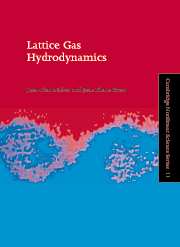Book contents
- Frontmatter
- Contents
- Preface
- Chapter 1 Basic ideas
- Chapter 2 Microdynamics: general formalism
- Chapter 3 Microdynamics: various examples
- Chapter 4 Equilibrium statistical mechanics
- Chapter 5 Macrodynamics: Chapman–Enskog method
- Chapter 6 Linearized hydrodynamics
- Chapter 7 Hydrodynamic fluctuations
- Chapter 8 Macrodynamics: projectors approach
- Chapter 9 Hydrodynamic regimes
- Chapter 10 Lattice gas simulations
- Chapter 11 Guide for further reading
- Appendix Mathematical details
- References
- Author index
- Subject index
Chapter 8 - Macrodynamics: projectors approach
Published online by Cambridge University Press: 13 October 2009
- Frontmatter
- Contents
- Preface
- Chapter 1 Basic ideas
- Chapter 2 Microdynamics: general formalism
- Chapter 3 Microdynamics: various examples
- Chapter 4 Equilibrium statistical mechanics
- Chapter 5 Macrodynamics: Chapman–Enskog method
- Chapter 6 Linearized hydrodynamics
- Chapter 7 Hydrodynamic fluctuations
- Chapter 8 Macrodynamics: projectors approach
- Chapter 9 Hydrodynamic regimes
- Chapter 10 Lattice gas simulations
- Chapter 11 Guide for further reading
- Appendix Mathematical details
- References
- Author index
- Subject index
Summary
It is one of the main objectives of statistical mechanics to provide a microscopic content to the phenomenologically established macroscopic properties and behavior of systems with many degrees of freedom. Although it is not necessary to have a complete knowledge of the details of the microscopic interactions to describe macroscopic phenomena in fluid systems, these phenomena emerge as a consequence of the basic dynamical processes. However, to establish rigorously the connection between the phenomenology and the underlying microscopic processes amounts to solving the many-body problem. Even for systems with oversimplified microscopic dynamics, such as lattice gas automata, this is an impossible task: approximations are unavoidable.
In this chapter we derive the equations governing the macroscopic dynamics of LGAs satisfying the semi-detailed balance condition; we shall start from the microscopic dynamics of the automaton, and use the lattice Boltzmann approximation (Suárez and Boon, 1997a,b). The main objective is to obtain the non-linear hydrodynamic equations, where the Euler and dissipative contributions are expressed in terms of the microscopic evolution rules of the automaton, and whose validity is not restricted to regions close to equilibrium, so that they can be used to analyze phenomena taking place in systems arbitrarily far from equilibrium, for instance in thermal LGAs under large temperature gradient.
In order to derive the hydrodynamic equations, we make use of the Boltzmann hypothesis (see Section 4.4.2) that particles entering a collision are uncorrelated.
- Type
- Chapter
- Information
- Lattice Gas Hydrodynamics , pp. 183 - 198Publisher: Cambridge University PressPrint publication year: 2001



